Monthly Updates on Recent Books in the History of Christianity
To raise awareness of recent books in the history of Christianity, the editorial staff of Church History: Studies in Christianity and Culture highlights each month a list of 10-15 books in diverse periods and geographical regions that we hope will be of interest to our members. We include here below the 30th monthly list, chosen by our staff, with excerpts from the publishers’ blurbs.

Catherine L. Albanese, The Delight Makers: Anglo-American Metaphysical Religion and the Pursuit of Happiness. 2023
The pursuit of happiness weaves disparate strands of Anglo-American religious history together. In The Delight Makers, Catherine L. Albanese unravels a theology of desire tying Jonathan Edwards to Ralph Waldo Emerson to the religiously unaffiliated today. As others emphasize redemptive suffering, this tradition stresses the “metaphysical” connection between natural beauty and spiritual fulfillment. In the earth’s abundance, these thinkers see an expansive God intent on fulfilling human desire through prosperity, health, and sexual freedom. Through careful readings of Cotton Mather, Andrew Jackson Davis, William James, Esther Hicks, and more, Albanese reveals how a theology of delight evolved alongside political overtures to natural law and individual liberty in the United States.

Arabella Cortese, Cilicia as Sacred Landscape in Late Antiquity: A Journey on the Trail of Apostles, Martyrs, and Local Saints. 2022
Cilicia as Sacred Landscape in Late Antiquity is a journey of discovery of the rich religious landscape of Cilicia in Asia Minor in Late Antiquity, with its contrasting and fascinating natural landscapes. Famous and prosperous cities of Cilicia Pedias such as Tarsos and Anazarbos welcomed pilgrims from distant western lands on their way to Jerusalem, attracted by famous stories about their saints and especially the Apostle Paul. The rugged mountains that characterized the western part of Cilicia (so-called Isauria) concealed places of worship associated mainly with the memory of Saint Thekla, whose place of pilgrimage was located a few kilometres south of the city of Seleukeia on the Kalykadnos, and of local martyrs, like Saint Konon, who were sometimes venerated internationally.
The present book examines all the archaeological and architectural evidence (building remains, inscriptions, decorations, mosaics, coins) that testify to the veneration of saints in Cilicia and Isauria, and integrates them with hagiographic evidence that tells us, above all, about the places where the saints stayed, performed their miracles, and died.
This volume is an archaeological work that focuses on the late antique process of creating sacred space in a marginal but extensively travelled region of Asia Minor. Combining the architectural and archaeological analysis of Christian church buildings and martyria with literary sources attesting the cult of a saint, it aims to reconstruct the sacred landscape of an underestimated region through the lens of a pilgrim and contributes towards the understanding of the pilgrim networks on the way to Jerusalem.
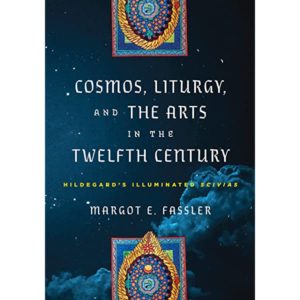
Margot Fassler, Cosmos, Liturgy, and the Arts in the Twelfth Century: Hildegard’s Illuminated Scivias. 2023
University of Pennsylvania Press
In Cosmos, Liturgy, and the Arts in the Twelfth Century, Margot E. Fassler takes readers into the rich, complex world of Hildegard of Bingen’s Scivias (meaning “Know the ways”) to explore how medieval thinkers understood and imagined the universe.
In Cosmos, Liturgy, and the Arts in the Twelfth Century, Margot E. Fassler takes readers into the rich, complex world of Hildegard of Bingen’s Scivias (meaning “Know the ways”) to explore how medieval thinkers understood and imagined the universe. Hildegard, renowned for her contributions to theology, music, literature, and art, developed unique methods for integrating these forms of thought and expression into a complete vision of the cosmos and of the human journey. Scivias was Hildegard’s first major theological work and the only one of her writings that was both illuminated and copied by scribes from her monastery during her lifetime. It contains not just religious visions and theological commentary, but also a shortened version of Hildegard’s play Ordo virtutum (“Play of the virtues”), plus the texts and music of fourteen musical compositions.
These elements of Scivias, Fassler contends, form a coherent whole demonstrating how Hildegard used theology and the liturgical arts to lead and to teach the nuns of her community. Hildegard’s visual and sonic images unfold slowly and deliberately, opening up varied paths of knowing. Hildegard and her nuns adapted forms of singing that they believed to be crucial to the reform of the Church in their day and central to the ongoing turning of the heavens and to the nature of time itself. Hildegard’s vision of the universe is a “Cosmic Egg,” as described in Scivias, filled with strife and striving, and at its center unfolds the epic drama of every human soul, embodied through sound and singing. Though Hildegard’s view of the cosmos is far removed from modern understanding, Fassler’s analysis reveals how this dynamic cosmological framework from the Middle Ages resonates with contemporary thinking in surprising ways, and underscores the vitality of the arts as embodied modes of theological expression and knowledge.
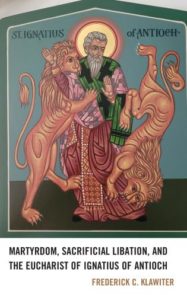
Frederick C. Klawiter, Martyrdom, Sacrificial Libation, and the Eucharist of Ignatius of Antioch. 2022
After showing that sacramental realism exists in neither Ignatius nor in John 6:51b-58, Frederick G. Klawiter argues that Ignatius’ eucharist contained a sacrificial wine libation (poured into a dish on the altar), symbolizing the pouring out of Jesus’ blood in his sacrificial death. Then, by drinking from the libation cup in the eucharist/agape meal, Christians sought unity of agape with one another and the crucified, risen Jesus—while anticipating the possibility of martyrdom.
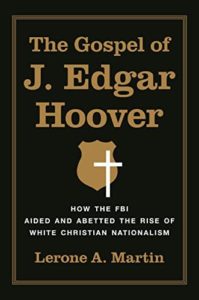
Lerone A. Martin, The Gospel of J. Edgar Hoover: How the FBI Aided and Abetted the Rise of White Christian Nationalism. 2023
On a Sunday morning in 1966, a group of white evangelicals dedicated a stained glass window to J. Edgar Hoover. The FBI director was not an evangelical, but his Christian admirers anointed him as their political champion, believing he would lead America back to God. The Gospel of J. Edgar Hoover reveals how Hoover and his FBI teamed up with leading white evangelicals and Catholics to bring about a white Christian America by any means necessary.
Lerone Martin draws on thousands of newly declassified FBI documents and memos to describe how, under Hoover’s leadership, FBI agents attended spiritual retreats and worship services, creating an FBI religious culture that fashioned G-men into soldiers and ministers of Christian America. Martin shows how prominent figures such as Billy Graham, Fulton Sheen, and countless other ministers from across the country partnered with the FBI and laundered bureau intel in their sermons while the faithful crowned Hoover the adjudicator of true evangelical faith and allegiance. These partnerships not only solidified the political norms of modern white evangelicalism, they also contributed to the political rise of white Christian nationalism, establishing religion and race as the bedrock of the modern national security state, and setting the terms for today’s domestic terrorism debates.
Taking readers from the pulpits and pews of small-town America to the Oval Office, and from the grassroots to denominational boardrooms, The Gospel of J. Edgar Hoover completely transforms how we understand the FBI, white evangelicalism, and our nation’s entangled history of religion and politics.

Lynneth Miller Renberg, Women, Dance, and Parish Religion in England, 1300-1640. 2022
The devil's cows, impudent camels, or damsels animated by the devil: late medieval and early modern authors used these descriptors and more to talk about dancers, particularly women. Yet, dance was not always considered entirely sinful or connected primarily to women: in some early medieval texts, dancers were exhorted to dance to God, arm-in-arm with their neighbors, and parishes were filled with danced expressions of faith. What led to the transformation of dancers from saints dancing after Christ into cows dancing after the devil?
Drawing on the evidence from medieval and early modern sermons, and in particular the narratives of the cursed carolers and the dance of Salome, this book explores these changing understandings of dance as they relate to religion, gender, sin, and community within the English parish. In parishes both before and during the English Reformations, dance played an integral role in creating, maintaining, uniting, or fracturing community. But as theological understandings of sacrilege, sin, and proper worship changed, the meanings of dance and gender shifted as well. Redefining dance had tangible ramifications for the men and women of the parish, as new definitions of what it meant to perform one's gender collided with discourses about holiness and transgression, leading to closer scrutiny and monitoring of the bodies of the faithful.
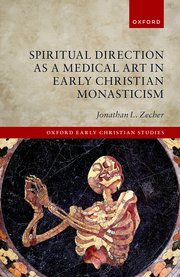
Jonathan L. Zecher, Spiritual Direction as Medical Art in Early Christian Monasticism. 2022
What expectations did the women and men living in early monastic communities carry into relationships of obedience and advice? What did they hope to achieve through confession and discipline? To explore these questions, this study shows how several early Christian writers applied the logic, knowledge, and practices of Galenic medicine to develop their own practices of spiritual direction. Evagrius reads dream images as diagnostic indicators of the soul's state. John Cassian crafts a nosology of the soul using lists of passions while diagnosing the causes of wet dreams. Basil of Caesarea pits the spiritual director against the physician in a competition over diagnostic expertise. John Climacus crafts pathologies of passions through demonic family trees, while equipping his spiritual director with a physician's toolkit and imagining the monastic space as a vast clinic. These different appropriations of medical logic and metaphors not only show us the thought-world of late antique monasticism, but they would also have decisive consequences for generations of Christian subjects who would learn to see themselves as sick or well, patients or healers, within monastic communities.

Terry Tastard, Nightingale’s Nuns and the Crimean War. 2023
Infectious disease, wounded and dying soldiers, and a shortage of supplies were the daily realities faced by the nuns who nursed with Florence Nightingale in the Crimean War. This study documents their involvement in the conflict and how the nuns bore witness to the effects of carnage and official indifference, in many cases traumatized as a result.
This book reflects on the initiative and courage shown by the nuns and how their actions can be viewed as part of a wider movement among women in the mid-19th century to find fulfilment and assert control in their own lives. Nightingale's Nuns and the Crimean War also sheds light on how critics at the time accused many of the nuns of being secret agents of the Catholic Church who preyed on vulnerable soldier patients; there was a campaign in parliament to regulate and control convents. Terry Tastard shows how the nuns attempted to neutralize this anti-Catholicism, as well as charting the participation of Anglican nuns who had just begun an astonishing project to revive the religious life in the Church of England. Finally the book reveals new insights into Florence Nightingale's relationships with the nuns who nursed with her in Crimea and how these experiences impacted Nightingale's own perspective.
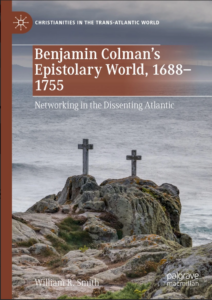
William R. Smith, Benjamin Colman’s Epistolary World, 1688-1755: Networking in the Dissenting Atlantic. 2022
This book tells the story of the Rev. Benjamin Colman (1673-1747), one of eighteenth-century America’s most influential ministers, and his transatlantic social world of letters. Exploring his epistolary network reveals how imperial culture diffused through the British Atlantic and formed the Dissenting Interest in America, England, and Scotland. Traveling to and living in England between 1695-1699, Colman forged enduring connections with English Dissenters that would animate and define his ministry for nearly a half century. The chapters reassemble Colman’s epistolary web to illuminate the Dissenting Interest’s broad range of activities through the circulation of Dissenting histories, libraries, missionaries, revival news, and provincial defenses of religious liberty. This book argues that over the course of Colman’s life the Dissenting Interest integrated, extended, and ultimately detached, presenting the history of Protestant Dissent as fundamentally a transatlantic story shaped by the provincial edges of the British Empire.

Thérèse Peeters, Trust in the Catholic Reformation: Genoa 1594–1664. 2022
In Trust in the Catholic Reformation, Thérèse Peeters shows how trust and distrust affected reform attempts in the post-Tridentine Church, while offering a multifaceted account of day-to-day religiosity in seventeenth-century Genoa, a city that has largely been overlooked in Anglophone scholarship. The book addresses diverse aspects of early modern Catholicism among lay people and members of the clergy. The author replaces the traditional view of the Catholic Reformation as a top-down process with one that considers individual agency, highlighting how strategies for gaining and maintaining trust – as well as the processes by which trust could be lost or denied – determined the success or failure of various efforts at reforming the Church.
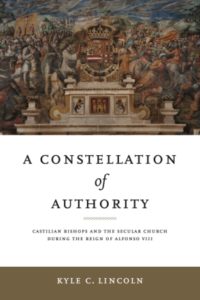
Kyle C. Lincoln, A Constellation of Authority: Castilian Bishops and the Secular Church during the Reign of Alfonso VIII. 2023
Pennsylvania State University Press
During the long reign of Alfonso VIII, Castilian bishops were crusaders, castellans, cathedral canons, and collegiate officers, and they served as powerful intermediaries between the pope and the king of Castile. In A Constellation of Authority, Kyle C. Lincoln traces the careers of a septet of these bishops and uses this history to fill in much of what really happened in thirteenth-century Castile.
The relationships that local prelates cultivated with Alfonso VIII and the Castilian royal family existed in tension with how they related to the reigning pope. Drawing on diocesan archives, monastic collections, and chronicles, Lincoln reconstructs the complex negotiations and navigations these bishops undertook to maintain the balance among the papal and royal agendas and their own interests. Lincoln examines the bishops' ties to crusades and political influence, the growth of canon and Roman law, religious and church reform, and the canonization of local leaders. In the process, he makes the case that the medieval past is best illuminated by the combined luminescence of a "constellation of authority" represented, at least in part, by a conglomerate of bishops.
Through seven case studies, each examining a prelate in his individual historical context, A Constellation of Authority improves our understanding of the politics of thirteenth-century Castile and provides an important foundation for further consideration of the ties between Castile and the broader European medieval world. It will appeal to medieval Hispanists and historians of the medieval church and episcopacy.

John R. Haddad, Cultures Colliding: American Missionaries, Chinese Resistance, and the Rise of Modern Institutions in China. 2023
As incredible as it may seem, the American missionaries who journeyed to China in 1860 planning solely to spread the Gospel ultimately reinvented their entire enterprise. By 1900, they were modernizing China with schools, colleges, hospitals, museums, and even YMCA chapters. In Cultures Colliding, John R. Haddad nimbly recounts this transformative institution-building—how and why it happened—and its consequences.
When missionaries first traveled to rural towns atop mules, they confronted populations with entrenched systems of belief that embraced Confucius and rejected Christ. Conflict ensued as these Chinese viewed missionaries as unwanted disruptors. So how did this failing movement eventually change minds and win hearts? Many missionaries chose to innovate. They built hospitals and established educational institutions offering science and math. A second wave of missionaries opened YMCA chapters, coached sports, and taught college. Crucially, missionaries also started listening to Chinese citizens, who exerted surprising influence over the preaching, teaching, and caregiving, eventually running some organizations themselves. They embraced new American ideals while remaining thoroughly Chinese.
In Cultures Colliding, Haddad recounts the unexpected origins and rapid rise of American institutions in China by telling the stories of the Americans who established these institutions and the Chinese who changed them from within. Today, the impact of this untold history continues to resonate in China.
Finally, for staying up-to-date on the latest titles in all fields, we recommend regularly perusing New Books Network and its "New Books in Christian Studies” page. These pages are updated regularly.
